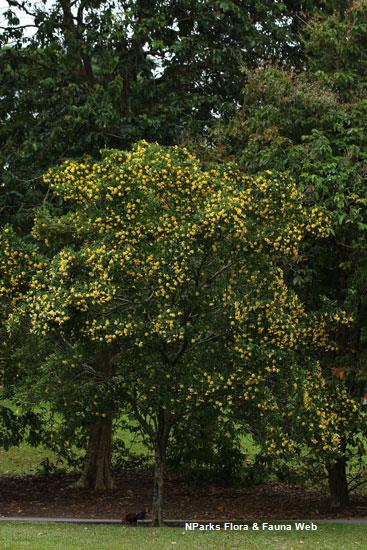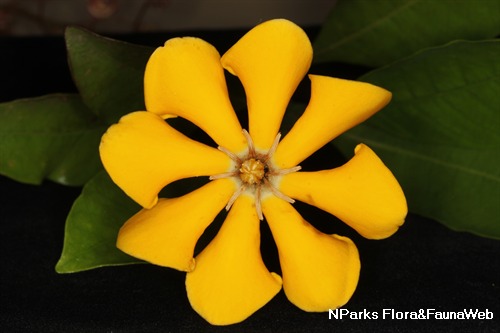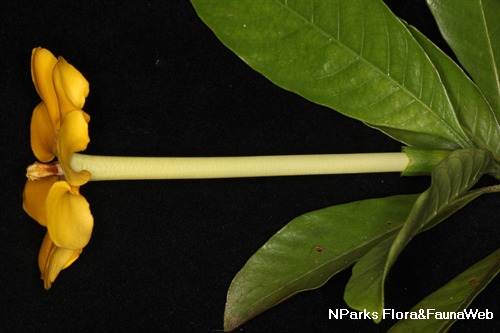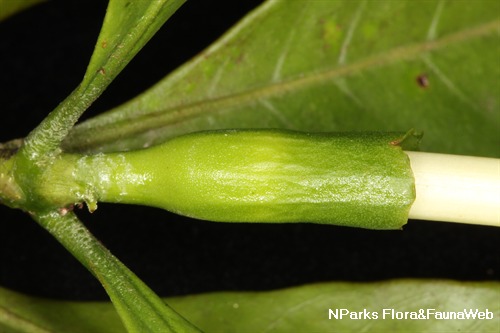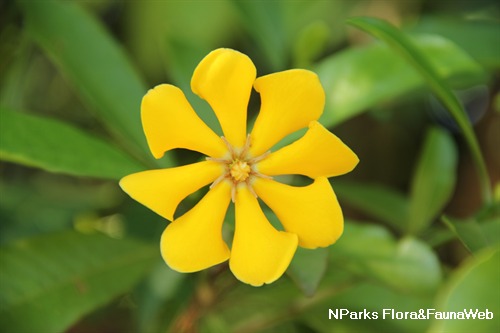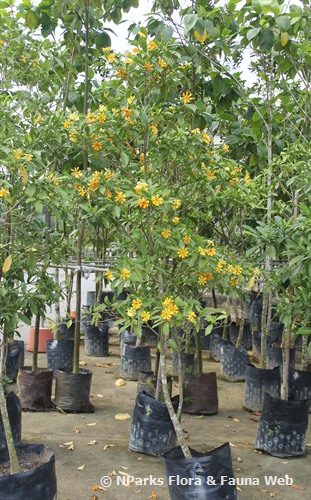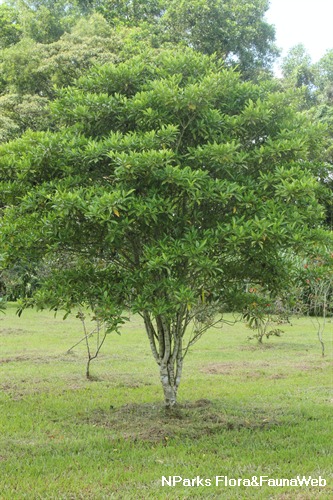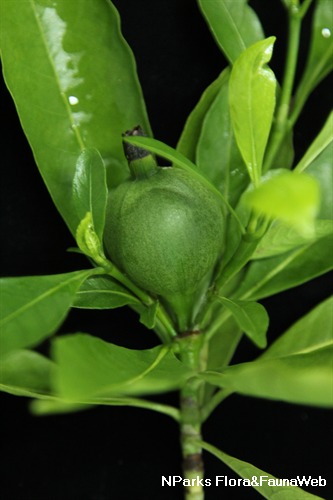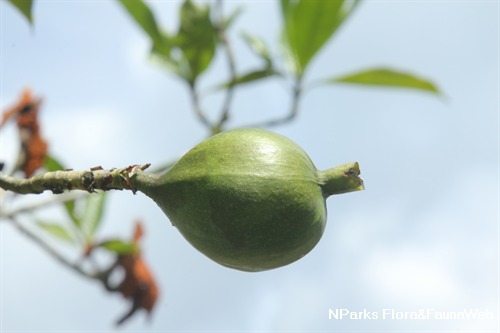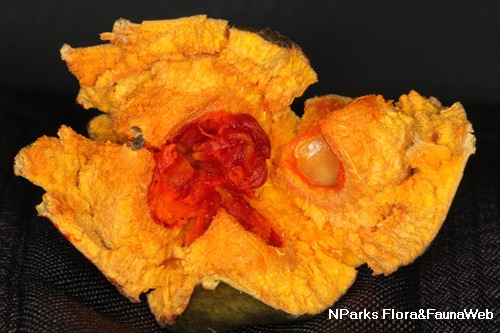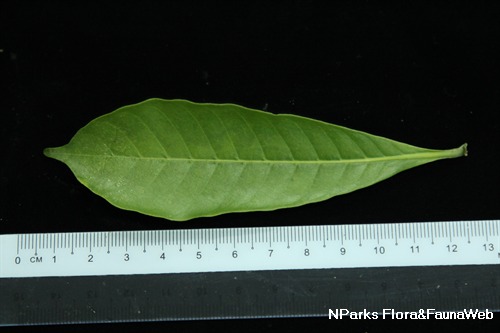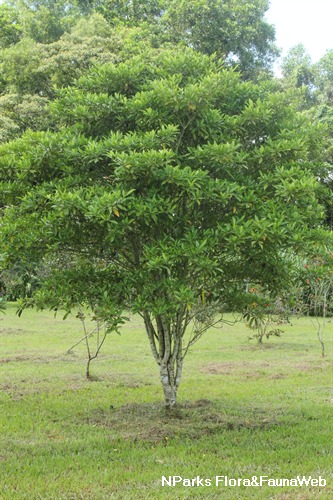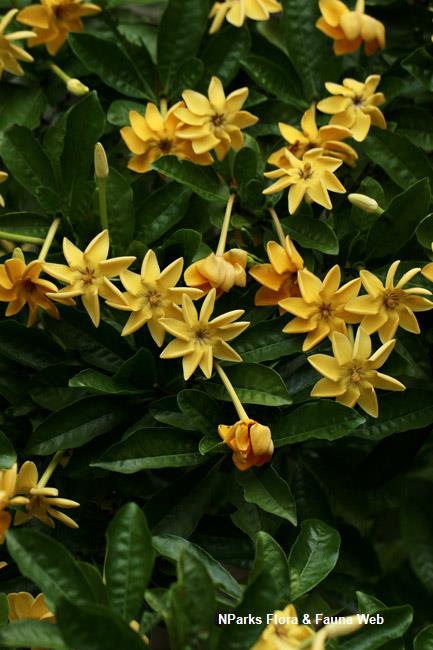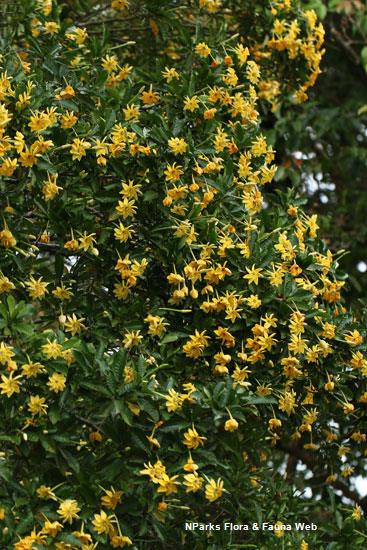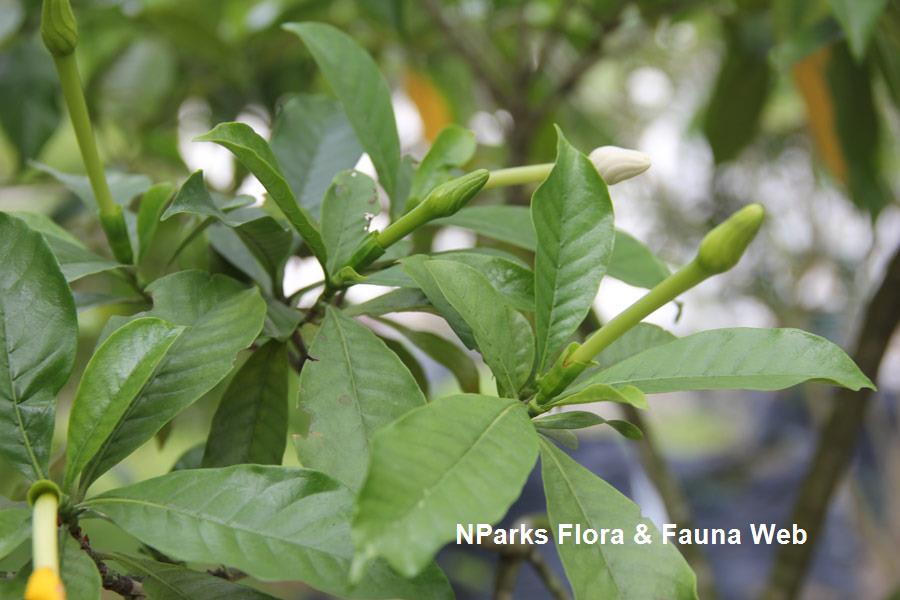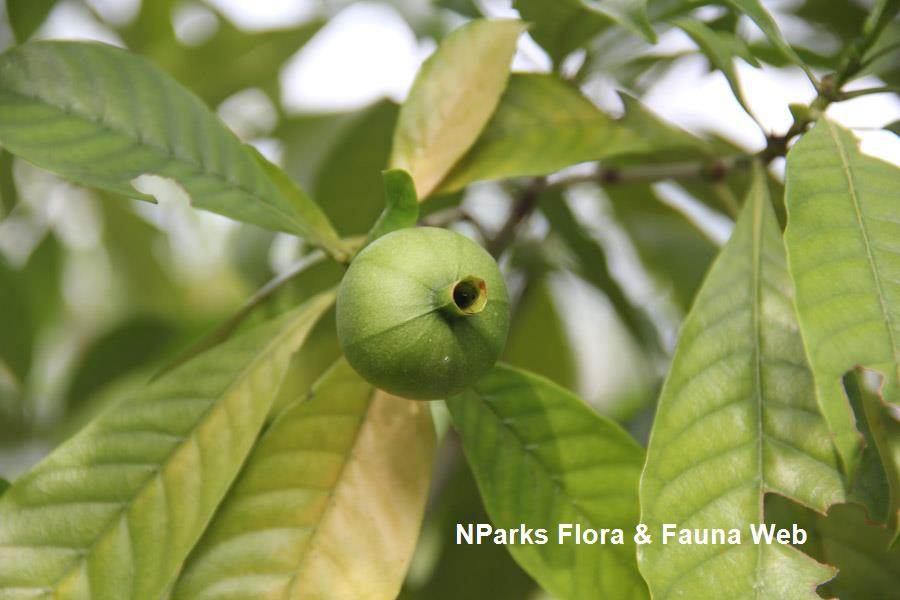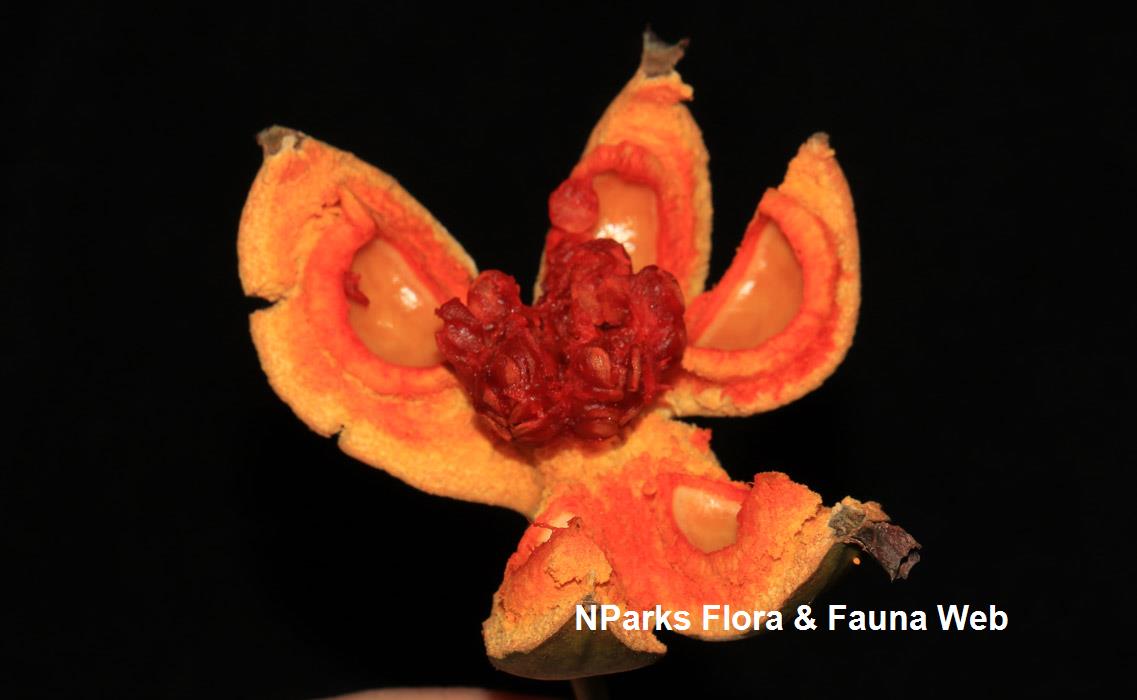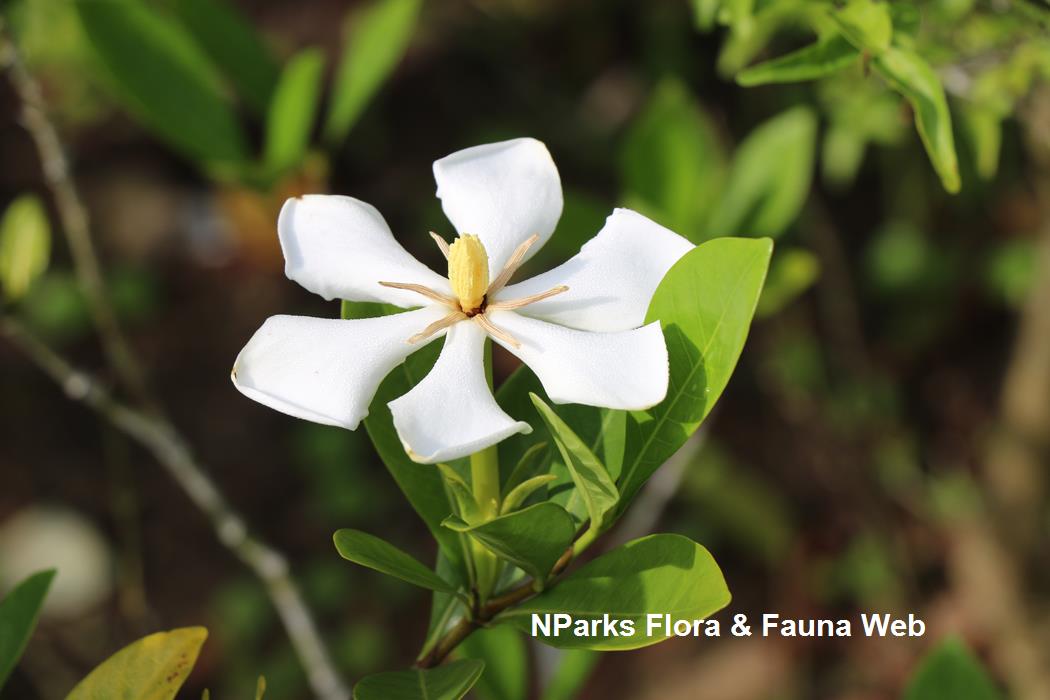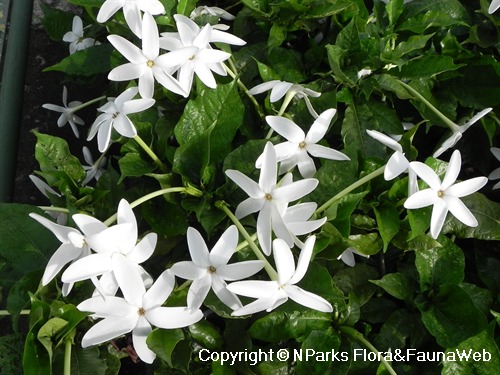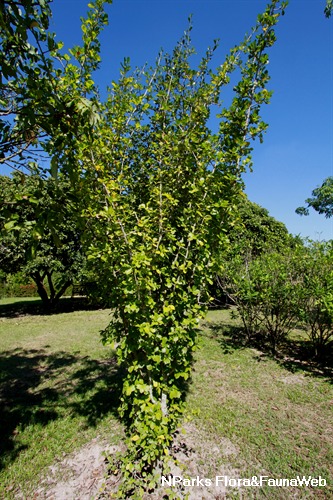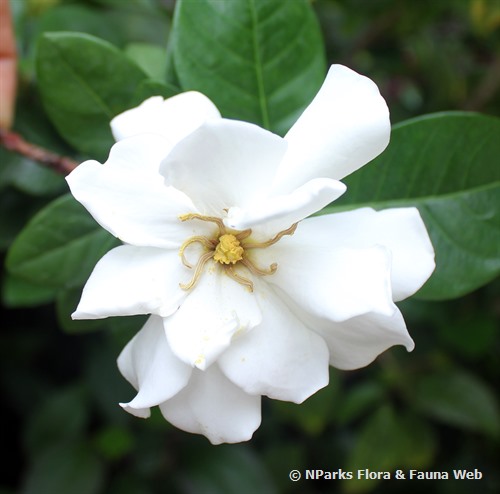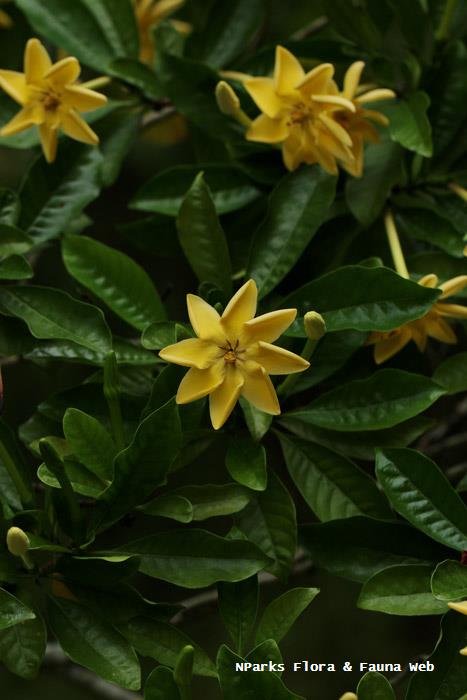
Back
Gardenia tubifera Wall.
| Family Name: | Rubiaceae |
| Common Name: | Water Gardenia, Golden Gardenia, Mentiong, Pekan Heran, Chempaka Utan, Delima Hutan |
Gardenia tubifera is a tree with ornamental fragrant flowers. Found naturally in swamp forests and coastal estuarine areas, it thrives in cultivation when grown under full sunlight and fertile, well-drained soil.
Name
Classifications and Characteristics
| Plant Division | Angiosperms (Flowering Seed Plants) |
|---|---|
| Plant Growth Form | Tree |
| Lifespan (in Singapore) | Perennial |
| Mode of Nutrition | Autotrophic |
| Plant Shape | Irregular |
| Maximum Height | 12 m |
Biogeography
| Native Distribution | Thailand, Peninsular Malaysia, Sumatra and Borneo |
|---|---|
| Native Habitat | Terrestrial |
| Preferred Climate Zone | Tropical |
| Local Conservation Status | Native to Singapore (Presumed Nationally Extinct (NEx)) |
Description and Ethnobotany
| Growth Form | It is a tree, up to 12 m tall with light grey-brown to dark brown smooth bark. |
|---|---|
| Foliage | Leaves are obovate, measuring (3.1–) 6.8 – 20.4 cm long and (1.4–) 2.9 – 7.7 cm wide, and in opposite arrangement. Each leaf has 9 – 16 pairs of lateral veins with hairy domatia in the axils on the lower leaf surface. The leaf tip is sharply pointed (acute) to tapering (cuneate) while the base is wedged shaped (cuneate). The stipule is fused and forming a cylindrical tubular structure (about 0.4 – 0.7 cm long) and minutely hairy (puberulent) on the outside. The stipule is often coated with resin. The tip of the stipule is slightly 2-lobed to subtruncate. The petiole is (0.2–) 0.9 – 2.1 cm long and covered with minute hairs. |
| Flowers | Flower occurs in solitary. They are fragrant and cream to yellow coloured. Fresh flowers are observed to be cream coloured and gradually turn orange yellow over time. It is salver-shaped with long slender tube, reaching up to 3.5 – 7.1 cm long, and 6 – 8 lobes, measuring 1.3 – 3.1 cm long. The flower is hairy at the throat and comprises of 6 – 9 stamens occurring between the flower lobes just below the throat. The style is glabrous while the stigma is club-like and protrudes out of the flower throat. Calyx is subtruncate, about 0.9 – 1.8 cm long, and loosely sheathing the corolla tube (0.5 – 0.8 cm wide at the apex). The surface of the calyx is smooth and without keels or rib. It is sometimes marked with longitudinal lines. |
| Fruit | The fruit is globose, measuring (2 –) 2.5 – 3 cm diameter, with a persistent calyx at the tip (up to 1.3 cm long). At maturity, the surface of the fruit remains smooth, and it splits open irregularly, revealing many seeds which are surrounded by bright yellow-orange pulp. |
| Habitat | It is found in swamp forests and coastal estuarine areas. |
| Associated Fauna | It is pollinated by insects. |
| Cultivation | It can be propagated by seed. |
| Etymology | The genus Gardenia commemorates Alexander Garden (1730 – 1791), a Scottish naturalist who contributed significantly to the flora in America. The specific epithet, in Latin, means bearing tube, referring to its long corolla tubes. |
Landscaping Features
| Landscaping | It is cultivated in parks and along streetscapes for its ornamental fragrant flowers. it thrives in cultivation when grown under full sunlight and fertile, well-drained soil. |
|---|---|
| Desirable Plant Features | Ornamental Flowers, Fragrant |
| Landscape Uses | General, Suitable for Roadsides, Parks & Gardens, Small Gardens, Riverine |
| Thematic Landscaping | Golden Garden, Fragrant / Aromatherapy Garden |
Fauna, Pollination and Dispersal
| Fauna Pollination Dispersal Associated Fauna | Bird-Attracting (Fruits), Butterfly-Attracting (Flower Nectar) |
|---|---|
| Pollination Method(s) | Biotic (Fauna) |
| Seed or Spore Dispersal | Biotic (Fauna) |
Plant Care and Propagation
| Light Preference | Full Sun |
|---|---|
| Water Preference | Moderate Water, Lots of Water |
| Plant Growth Rate | Moderate |
| Rootzone Tolerance | Moist Soils, Well-Drained Soils, Fertile Loamy Soils |
| Maintenance Requirements | Moderate |
| Propagation Method | Seed |
Foliar
| Foliage Retention | Evergreen |
|---|---|
| Mature Foliage Colour(s) | Green |
| Mature Foliage Texture(s) | Leathery |
| Foliar Type | Simple / Unifoliate |
| Foliar Arrangement Along Stem | Opposite |
| Foliar Attachment to Stem | Petiolate |
| Foliar Shape(s) | Non-Palm Foliage (Obovate) |
| Foliar Venation | Pinnate / Net |
| Foliar Margin | Entire |
| Leaf Area Index (LAI) for Green Plot Ratio | 3.0 (Tree - Intermediate Canopy) |
Non - Foliar and Storage
| Trunk Type (Non Palm) | Woody |
|---|---|
| Root Type | Underground |
Floral (Angiosperm)
| Flower & Plant Sexuality | Bisexual Flowers |
| Flower Colour(s) | Cream / Off-White, Yellow / Golden, Orange |
|---|---|
| Flower Grouping | Solitary |
| Flower Symmetry | Radial |
| Individual Flower Shape | Tubular, Salverform |
| Flowering Period | A Few Times Yearly |
References
| References | <1> Low, Y.W. & Wong, K.M. (2009). Old Hats Are Better: New Considerations and Taxonomic Changes in the Southeast Asian Gardenia tubifera Complex (Rubiaceae). Gardens' Bulletin Singapore 61: 101-128. <2> Wong, K.M., Turner, I.M. Wang, R.J., Harwood, R., Seah, W.W., Ng, X.Y., Lim, R.C.J., Lua, H.K., and Mahyuni, R. (2019). Rubiaceae. In: Middleton, D.J., Leong-Škorničková, J. & Lindsay, S. (ed.) Flora of Singapore, vol. 13, pp. 1–358. Singapore: National Parks Board. |
|---|
Image Repository
Others
| Master ID | 1640 |
|---|---|
| Species ID | 2933 |
| Flora Disclaimer | The information in this website has been compiled from reliable sources, such as reference works on medicinal plants. It is not a substitute for medical advice or treatment and NParks does not purport to provide any medical advice. Readers should always consult his/her physician before using or consuming a plant for medicinal purposes. |

